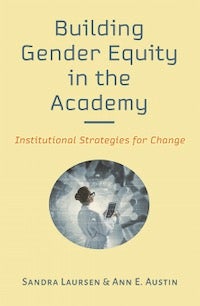 Building Gender Equity in the Academy: Institutional Strategies for Change comes from over a decade of research studying the experiences of ADVANCE projects in the the US that have sought to heighten gender equity on STEM faculties in higher education. Authors Sandra Laursen and Ann E. Austin have distilled this research into a handbook and how-to guide for leaders in academic institutions—busy people who want to make evidence-based decisions on what to do to increase gender equity, and who need to know how to do it. And it is also for emerging leaders, young and old, who can nudge those in power and prepare to lead themselves someday.
Building Gender Equity in the Academy: Institutional Strategies for Change comes from over a decade of research studying the experiences of ADVANCE projects in the the US that have sought to heighten gender equity on STEM faculties in higher education. Authors Sandra Laursen and Ann E. Austin have distilled this research into a handbook and how-to guide for leaders in academic institutions—busy people who want to make evidence-based decisions on what to do to increase gender equity, and who need to know how to do it. And it is also for emerging leaders, young and old, who can nudge those in power and prepare to lead themselves someday.
The heart of the book is a collection of 12 research-based strategies, organized in four groups by what part of the gender equity problem they address. The authors offer a rationale for each strategy, a variety of models, and advice from experience and data about how an institution might choose, implement and evaluate them. The opening section offers a succinct literature review—what is the problem, how is it gendered and grounded in STEM—and describes our research. And the book closes with a synthesis about how the strategies are context-sensitive and how to analyze your own organizational context to make choices about which of the strategies best fit for your particular institution.
We wrote this book to help people make change. While the research is based on institutions of higher education, we think the strategies are more broadly applicable to other workplaces that share some characteristics with academe, such as national labs, high tech, or R&D organizations. And, while the ADVANCE projects we studied were focused on gender, many of the strategies also readily adapt to address other dimensions of equity, such as race, ethnicity, class, disability, Indigenous status, and more.
Building Gender Equity in the Academy: Institutional Strategies for Change by Sandra Laursen and Ann E. Austin is published by the Johns Hopkins University Press.
The authors thank our editors, Greg Britton and Kyle Gipson; our eagle-eyed copy editor, Merryl Sloane; our thoughtful indexer, Margaret Puskar-Pasewicz; our reviewers and endorsers; and the excellent team at JHUP who helped to bring this work to you. We are grateful to colleagues throughout the ADVANCE community for their work, their insights, and their generosity of information, ideas, and critical commentary.
This work was supported by the National Science Foundation under awards HRD-0930097 and HRD-1830185. Any opinions, findings, conclusions, or recommendations expressed in these reports are those of the researchers, and do not necessarily represent the official views, opinions, or policy of the National Science Foundation.
